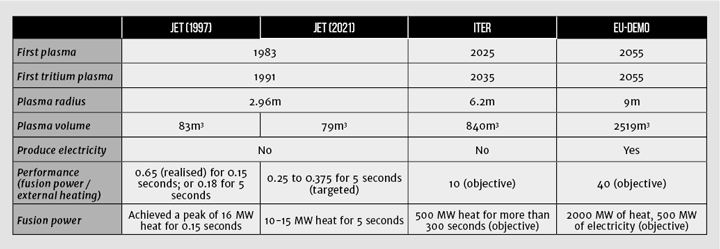New energy record is ‘resounding confirmation in global fusion quest’
FUSION researchers have achieved a record-breaking sustained burst of energy that they say is the clearest indication in a quarter of a century that fusion technology can produce abundant low-carbon energy.
Experiments at the Joint European Torus (JET) facility in the UK produced a total of 59 MJ of heat energy from fusion over a five second period, beating the previous record of 22 MJ set at the facility in 1997. While the duration may sound short, it was limited by JET’s copper electromagnets, which are not cryogenically cooled so can only handle the heat load from the high-energy plasma discharges for five seconds.
Tony Donné, Programme Manager for the EUROfusion consortium that oversees the research, said: “The record, and more importantly the things we’ve learned about fusion under these conditions and how it fully confirms our predictions, show that we are on the right path to a future world of fusion energy. If we can maintain fusion for five seconds, we can do it for five minutes and then five hours as we scale up our operations in future machines.”
EUROfusion consists of 30 research organisations from 28 European countries, which plan on using the lessons learned at JET to produce net fusion energy at a larger facility called ITER that is being constructed in France.
Bernard Bigot, Director General of ITER, said: “A sustained pulse of deuterium-tritium fusion at this power level – nearly industrial scale – delivers a resounding confirmation to all of those involved in the global fusion quest.”
Fusion tests have yet to produce more energy than has to be put in to get the fusion process started. ITER intends to become the first to produce net energy once it begins trials in 2025, though will not convert the heat it produces into power due to the extra equipment cost. That will be the role of the European EU DEMO demonstration power plant which aims to produce net fusion energy for electricity generation for the first time from around 2055.

Fuel mix
The record result from JET (see video of the experiment, below) was the first time in 25 years that a fusion experiment has used a mixture of deuterium and tritium fuel – the same fuel that ITER is planning to use. Most tests in recent years have only used deuterium. While deuterium is abundant in seawater, tritium is radioactive and rare. It is currently produced in nuclear fission reactors. For JET’s recent experiments, 60 g of tritium was provided by a Canadian CANDU reactor. Fortunately, the fusion processes of the future will be designed to breed their own tritium fuel.
The fusion process combines light atoms at temperatures exceeding 100moC. At these extremes, the particles can be forced to overcome the forces that repel them and fuse together releasing energy. The process involves heating the atoms inside a donut-shaped reactor called a tokamak, where they divide into positive and negative ions and form a plasma that is manipulated with magnets to prevent it from touching the reactor walls.
When deuterium and tritium fuse they produce helium which serves to heat up the surrounding fuel to maintain the plasma conditions and it releases a neutron which moves at 52,000 km/s, carrying the fusion energy out of the plasma. In a commercial fusion plant, the neutron would carry the fusion energy into a blanket containing lithium that surrounds the reaction chamber. This would convert lithium into tritium fuel to feed the fusion process and heat up the blanket which would be used to heat water and drive a turbine to produce electricity.
In the past 15 years, upgrades at JET include changing its carbon inner wall to a metal one made out of the beryllium and tungsten that will be used at ITER as well as additional heating, measurement and control systems. Researchers used the experiments to test their computer models, new diagnostics and plasma control techniques.
Ian Chapman, UKAEA’s CEO, said: “These landmark results have taken us a huge step closer to conquering one of the biggest scientific and engineering challenges of them all. It is reward for over 20 years of research and experiments with our partners from across Europe.
“It’s clear we must make significant changes to address the effects of climate change, and fusion offers so much potential. We’re building the knowledge and developing the new technology required to deliver a low carbon, sustainable source of baseload energy that helps protect the planet for future generations. Our world needs fusion energy.”
Last year, the UK Government released a strategy for how the country could become a commercial leader in nuclear fusion power.
Recent Editions
Catch up on the latest news, views and jobs from The Chemical Engineer. Below are the four latest issues. View a wider selection of the archive from within the Magazine section of this site.




